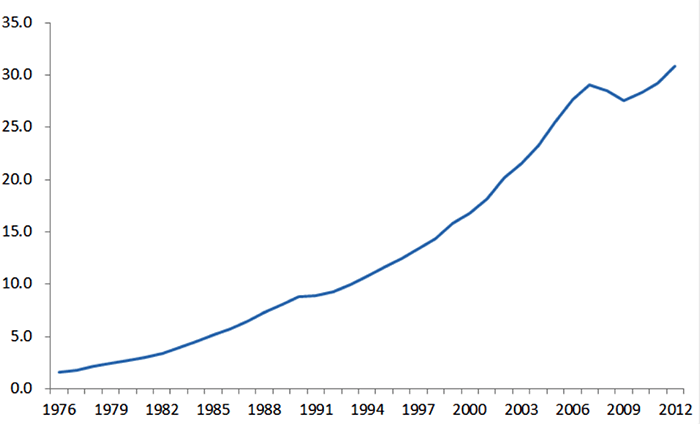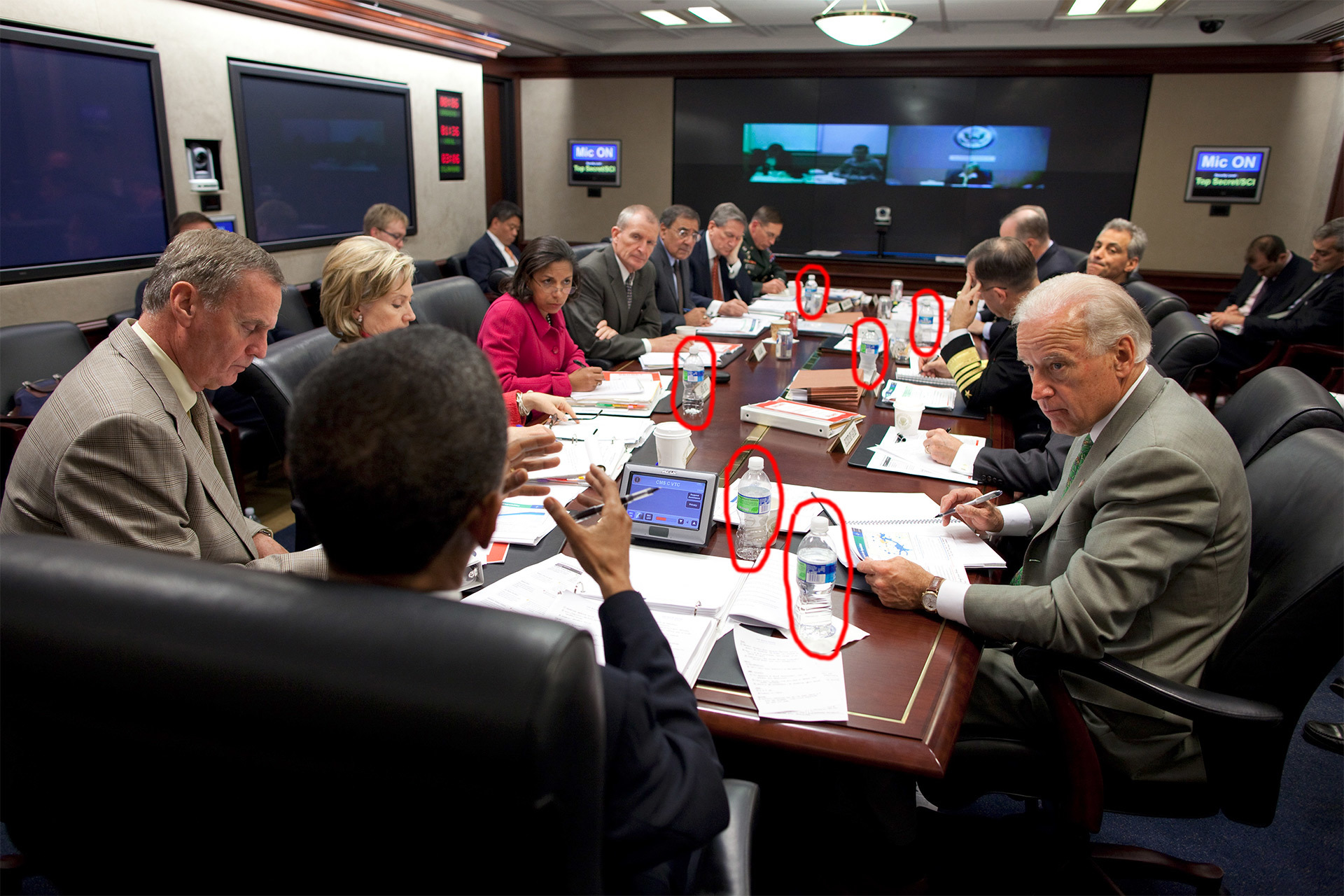"Reverse quarantine". Why do people think bottled water is better than tap water?

“Why do people think that bottled water is better than tap water?” - this question was asked by the staff of the Forbes research department on the famous Quora website and collected the opinions of scientists on this topic.
Specialists have long paid attention to the staggering success of a relatively new market success - bottled water, which is called the "superstar of the beverage industry." Few goods have managed in such a short time to make such an incredible journey from almost complete obscurity to an almost absolute standard of consumption.
')
If 40 years ago you suggested a person to buy in a store of pure water, he would look at you as if he was crazy. Now it does not surprise anyone.

Sales of bottled water in the United States from 1976 to 2012, in gallons per person per year (1 gallon = 3.7854 liters). Source of statistics: Statistics Beverage Marketing Corporation
In 1975, the average American consumed about 4 liters of bottled water per year. By 2005, this figure rose to 98 liters per year, and by 2012 - up to 114 liters per year.
“People may or may not believe that bottled water is better than tap water, but for the last twenty years here in the USA they are definitely exposed to advertising, that is how it is, and sales statistics confirm that this method works,” the immunologist comments on the consumer trend, PhD in Mycobacteriology Timuralai Kamala (Tirumalai Kamala).
The sociologist Andrew Szas, author of “ Buying Your Way to Security: How We Gone from Protecting the Environment to Protecting Ourself, ” offers a rather fascinating explanation of why and how bottled water sales have grown 100 times in the last decades. He calls this phenomenon " reverse quarantine " or "quarantine inside out." Created according to the classic quarantine model, it has become a distinct reaction of people to common threats, both real and fictional.
In the classical quarantine, the collective community and the environment are considered as a healthy space, and individual sources constitute a threat that must be prevented from spreading. Society protects itself by enclosing a source, for example, of infected / sick people. This reduces the likelihood that other people will be exposed to the infection and also begin to spread it. What happens when the threat is perceived as ubiquitous? What if the environment itself is perceived as toxic, dangerous? According to the sociologist, in the US, many healthy people respond to such a threat by isolating themselves from a potentially dangerous environment. Thus, this kind of “quarantine inside out” arises, which acts as a defense against the threat that a person sees everywhere.
A sociologist says that what is happening now is very different from the social movements of the past decades, when people reacted to threats through collective action. He believes that now the massive popularity of bottled water, "organic", "natural", "non-toxic" products, a variety of personal care products and other characteristic things - this is the final expression of personal individualism: assembling a personal commodity bubble for one body , trying to protect itself using individual shopping instead of collective action that would change the existing status quo.
In the case of specifically with bottled water, the scientist says, it all started with a mass suspicion about the quality of tap water. A decade ago, public opinion polls in the United States showed that citizens were dissatisfied with its quality: in 1999, a national poll by the National Consumer Water Quality Survey showed that about 75% of citizens are “concerned” about the quality of drinking water, and almost 50% suspect the possible presence of “polluting substances, hazardous to health. " Two years later, a similar survey showed that the numbers rose to 86% and 51%, respectively.
Thus, there is a widespread feeling among the population that drinking water can be poisoned by toxic industrial and agricultural chemicals .
As soon as the industry of soft drinks caught such public moods, she immediately jumped at this gold mine. She began to specifically promote bottled water as a safer alternative to tap water, specifically targeting those fears that consumers expressed in public opinion polls. As with the famous marketing of non-GMO products, bottled water progressed as a means of eliminating danger.
Specialized brands of “ spring water” ( spring water) appeared, which emphasized the crystal purity of their bottled water, which is isolated from “external influences”.
Here are some examples.
Evian
“Evian is born in the heart of the French Alps. For 15 years, it passes the path of natural filtration by rocks, acquiring impeccable purity and a unique mineral composition. Poured directly at the source and saved from external influences, Evian comes to you the way nature itself has created it. ”
Fiji water
“The trade winds passing through the islands of Fiji bring only pure, non-acid rain, not polluting the environment. The precipitation is filtered through the volcanic rocks of the mountains and collected in an underground artesian aquifer, from where the water is bottled. A specialized bottling line ensures that water is not contaminated by external factors that could jeopardize its cleanliness. ”
Other brands bottling water from a conventional water supply system focus on the “super-technological efforts” they put into cleaning water from toxins present.
Big Sur Water Company
“It passes through a carbon filter ... then it is passed through a vapor compression processor ... then through a 1 micron paper filter. When water passes through the filter, superacid in the form of ozone (O 3 ) is introduced into the water to ensure that our water remains in its purest form after bottling. ”
Ionic
“The Aqua CoolR Pure Bottled Water purification and production process involves using a set of Ionics ToolboxSM technologies [it includes reverse electrodialysis, reverse osmosis, ultrafiltration and adsorption] to completely remove all soluble and insoluble materials from the source water. The resulting high-purity water is then remineralized by a specific “menu” of minerals selected for taste and protection. ”
When such relentless and focused marketing reaches its goal, there is an increasing cycle with positive feedback. By making more and more efforts to purify water, manufacturing companies are increasingly strengthening people's faith that the source water contains toxic impurities, while at the same time creating the impression of a “special” purity of bottled water.
According to TGI Global, 87% of the population drink bottled water in Germany, and people prefer local brands: Gerolsteiner and Apollinaris.
In France, 89% of people drink bottled water, local producers also hold leading positions: Cristalline - 37% and Evian - 31%.
The level of consumption of bottled water in the United States also suggests that she won a final victory over tap water, at least on this example from Wikipedia . Among all the participants in the White House meeting, not one person drinks plain water from a glass.

Conference room at the White House
The irony of choosing bottled water instead of tap water is that, by doing so, manufacturers of various beverages receive an unconditional credit of trust, which in the same way may not be justified, writes Forbes.
Source: https://habr.com/ru/post/394863/
All Articles